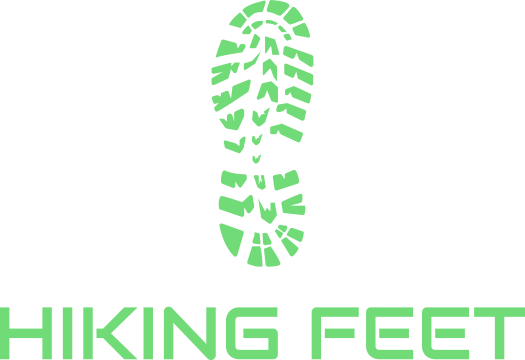My Merrell Moab 3 review gives you my first-hand take on the world's most popular—yet polarizing— hiking shoe. On one hand, the Moab is "the world's best-selling hiker" (according to Merrell), and hordes of hikers post "I love my Merrills" [sic] every time somebody asks for hiking shoe recommendations online. On the other hand, the Moab is a hiking shoe that outdoor industry professionals love to hate. Almost none of my co-workers in the outdoor industry actually hike in Merrells, and many won't recommend the Moab to their customers —much less their friends and family members. After Merrell released the updated Moab 3 in Summer, 2022, I personally tested and reviewed it to help you figure out if it's a good hiking shoe for you—or a good one to avoid.
This post includes affiliate links. If you click on an affiliate link and buy something, the retailer may share a small percentage of the sale with Hiking Feet. That's free for you—and gives you an easy way to support this site's free and independent content.
Review: Merrell Moab 3 Low
The Merrell Moab 3 Low is the latest version of the "Mother Of All Boots" ("M.O.A.B."). I sold millions of Moabs when I worked at Appalachian Outdoors and Backcountry, but I was never tempted to try them. However, when Merrell released version 3 of the Moab in Summer 2022, I picked up a discounted pair to test and review on Hiking Feet. I gauged my shoes' support on rocky stretches of Pennsylvania's Mid-State trail, tested their traction on short-but-steep trails with loose rock and scree, and also wore them casually since many people wear Moabs as everyday shoes. Based on my first-hand experience, I can see why Merrell's many fans—and detractors—have legimate points.
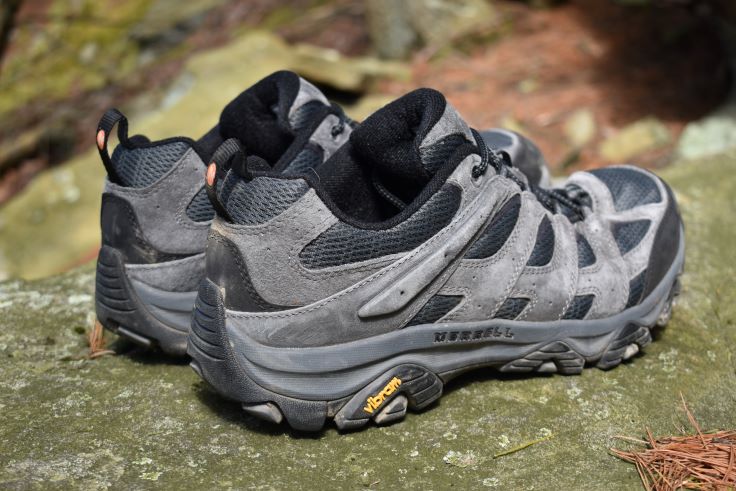
Support
One reason why many outdoor industry pros hate on the Moab is its mediocre support. Like most Merrells, it straddles the boundary between a (real) hiking shoe and (casual) everyday shoe. Many beginners and casual hikers like that "out of the box comfort" (which is a classic marketing term for crappy support). Meanwhile, many serious hikers and outdoor industry professionals consider Moabs to be glorified sneakers in the support department.
Maybe it's my imagination, but the 3rd generation Moab seems slighly beefier than the older Moabs that I sold at Appalachian Outdoors?! I could bend the older Moab easily at the mid-foot, and its torsional rigidity was also below average. Now the shoe flexes more at the ball of the foot—enough support for the average day hiker. For me, the Moab's just-about-average support is more palatable in the shoe version than boot version since most hikers aren't counting on low-cut hiking shoes for bomber protection.
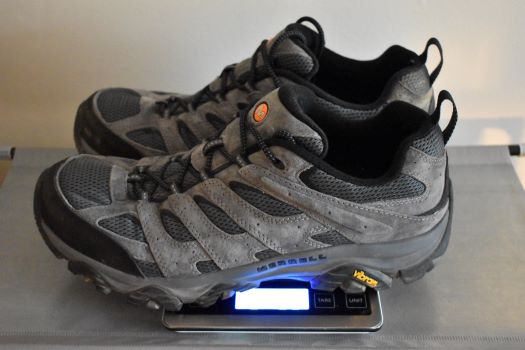
Weight
My pair of men's Moab 3 Low (non-waterproof) hiking shoes tipped the scales at 2 pounds 4 ounces (size 12 - wide). That's average to slightly heavy for a true hiking shoe today. This shoe's weight to support ratio isn't great: You get slightly below average support at an above average weight. That's one of the tradeoffs for choosing a budget hiking shoe over a performance hiking shoe.
Overall, the Merrell Moab 3's build profiles best for hikers who prioritize price over support or weight savings. For a lighter Merrell, you might try the Merrell Moab Speed 2 or the gender-specific Merrell Antora (women) or Nova (men)—or check out my picks for the best lightweight hiking shoes.
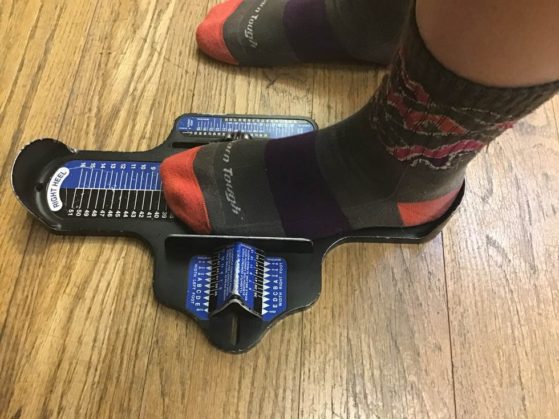
Fit
One of the best reasons to buy the Merrell Moab 3 is fit—if you have wide feet. I ordered the Moab 3 Low in wide since I need wide sizes in most brands. However, Merrell's wide surprisingly was too big for me?! My everyday shoe size is 11.5, and the 12 regular is my best fit in this shoe. With Merrell's regular size being as wide or wider than many brands' wides, the Moab may be a good call for hikers with really wide feet. If you have narrower feet (or even standard-sized feet), you should target another brand or browse the best hiking shoes for narrow feet. (Pro Tip: Heel slippage is a common issue in the Moab, especially if you don't have wide feet.)
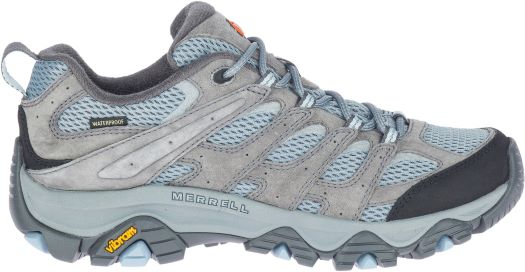
Comfort
Comfort has a lot to do with fit, personal preference, and matching your shoe to your hiking style. Many of my customers at Backcountry and Appalachian Outdoors swear by Merrell's cushioning, roomy fit, and "out of the box comfort." If you mostly hike easy to moderate trails, this shoe's build potentially can be comfortable for you.
However, my feet never quite gelled with the Moab—even on easier trails than I normally hike. I like the feel of Merrell's premium hiking boot, the Rogue Hiker. However, the Moab never quite felt right. It felt like my heel was sitting awkwardly on top of a block that wasn't completely connected to the rest of the shoe. Perhaps it's made for people with higher arches than me? The fit was kind of clunky, too—though it might have been a little better had I not ordered a wide. Ultimately, I gave my pair away after finishing enough test hikes to provide a fair review.
However, my feet aren't your feet. Most Merrell lovers keep buying Moab after Moab because of the shoe's comfort.
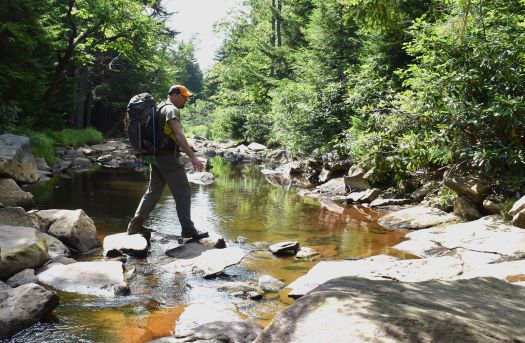
Weather Protection
For waterproofing, Merrell offers the Moab in its proprietary waterproof membrane or in more reliable and breathable GORE-TEX (which is more expensive). By design, I picked the non-waterproof Moab 3 Low since I know that Merrell's proprietary waterproofing doesn't have a strong reputation in the outdoor industry. The Moab 3 is one of the few hiking shoes available in a non-waterproof style—a potential selling point if you mostly hike in hot and dry environments.
My regular (non-waterproof) Moabs obviously didn't keep out the rain or snow, but they potentially make sense for fair-weather hikers. Having lived in Arizona and now in New Mexico, I can recommend the non-waterproof Merrell Moab 3 for desert day hikes. It wears a little cooler than most waterproof hiking shoes while providing enough protection against cacti and desert vegetation.

Traction
Merrell has sourced Vibram outsoles for its Moab series. Vibram rubber is a big plus at this price point. At the same time, the tread on the Moab 3 is more "multi-surface" or "work" tread than a true "trail" tread. This makes sense since many people wear Moabs as general outdoor shoes, everyday shoes, or trail-to-town shoes—not just for hiking.
When I scrambled up Shingletown Gap, I was only partially confident in the Moab's rock traction. On Mt Nittany, I slipped around a bit on steep, gravelly descents that I can fly down in other boots and shoes. My customers at Appalachian Outdoors complained about the Moab's traction on muddy PA trails. The moderate lugs perform better on well-defined trails than on steep trails, loose surfaces, snow, or mud.
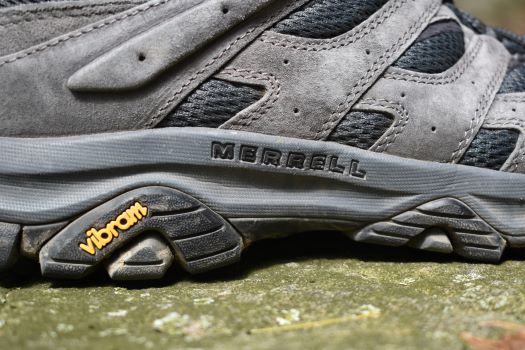
Vibram outsoles on the Merrell Moab 3 are a plus at this price point
Value
To Merrell's credit, the price on the Moab hasn't skyrocketed with inflation like many other outdoor brands. The non-waterproof low-cut starts at $120, and the waterproof starts at $140 (with optional GORE-TEX waterproofing costing $20 more). That's a below-average price for a shoe that's grades out just about average. With KEEN raising its prices, the Moab 3 stands out as one of the best buys in hiking footwear. That's why Hiking Feet has named the Merrell Moab 3 as one of the best hiking shoes on a budget.
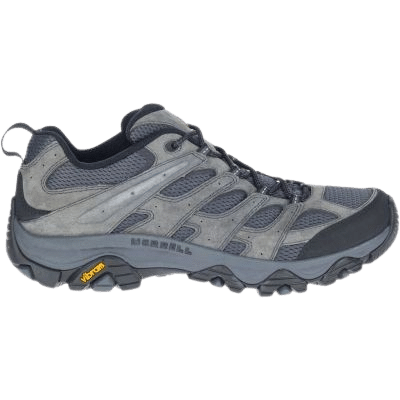
Men's Merrell Moab 3 Low
Check current price, styles, and colors:
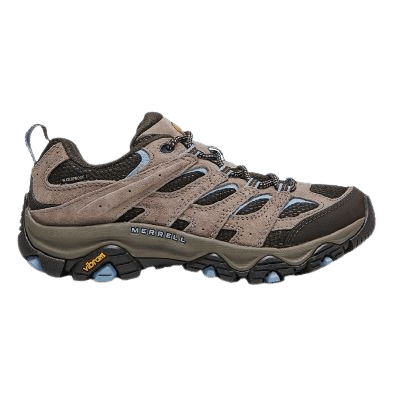
Women's Merrell Moab 3 Low
Check current price, styles, and colors:
Merrell Moab 3 Hiking Shoe: Pros vs. Cons
The Merrell Moab 3 Low is potentially a good buy for hikers who are more focused on price than performance. In a nutshell, it offers just-about-average performance at a better-than-average price. It's not as good of a hiking shoe as most Facebook users probably believe—and probably not as bad as many outdoor industry pros (including me) assume. I'm glad I gave it a fair go. Here's my first-hand take on this shoe's specific pros and cons;
Should you buy the Merrell Moab 3?
The Merrell Moab 3 is one of the best hiking shoes for hikers on a budget and a good fit for hikers with wide feet. It's enough shoe for the average day hiker. However, it's not the best choice for hikers who value support or weight savings more than price—or for hikers with narrower feet. If you're looking for premium hiking shoes, see my list of the best hiking shoes. If you need a narrower fit, here are the best hiking shoes for narrow feet. In my experience, the Moab most appeals to casual hikers, budget buyers, and people who mostly wear their hiking shoes as everyday shoes. I also recommend the non-waterproof Moab 3 as a desert hiking shoe.
Are you thinking about joining the 20 million other people who've bought the Merrell Moab? If so, please consider purchasing them through the links above. That doesn't cost you anything, but that helps keep this site afloat, helps me buy boots and shoes to review, and gives me a little bit back for all the unpaid hours I've poured in this website.
Happy hiking!
